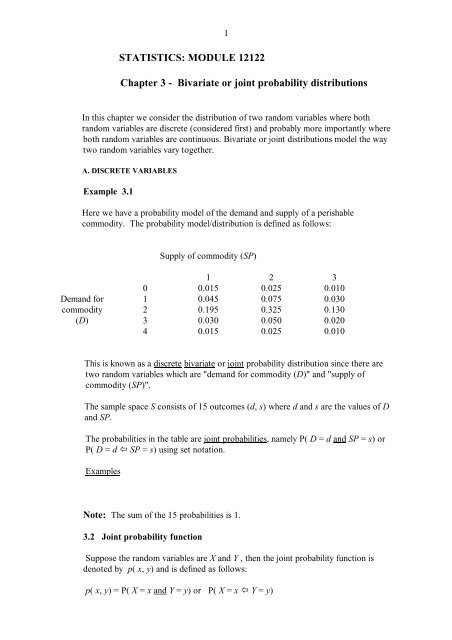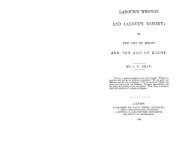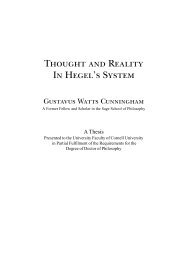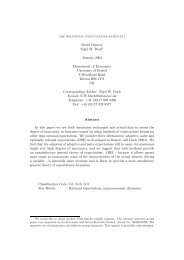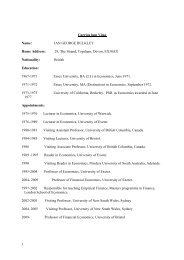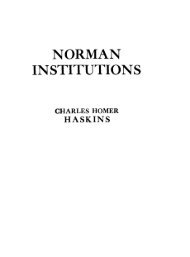Bivariate or joint probability distributions
Bivariate or joint probability distributions
Bivariate or joint probability distributions
Create successful ePaper yourself
Turn your PDF publications into a flip-book with our unique Google optimized e-Paper software.
1<br />
STATISTICS: MODULE 12122<br />
Chapter 3 - <strong>Bivariate</strong> <strong>or</strong> <strong>joint</strong> <strong>probability</strong> <strong>distributions</strong><br />
In this chapter we consider the distribution of two random variables where both<br />
random variables are discrete (considered first) and probably m<strong>or</strong>e imp<strong>or</strong>tantly where<br />
both random variables are continuous. <strong>Bivariate</strong> <strong>or</strong> <strong>joint</strong> <strong>distributions</strong> model the way<br />
two random variables vary together.<br />
A. DISCRETE VARIABLES<br />
Example 3.1<br />
Here we have a <strong>probability</strong> model of the demand and supply of a perishable<br />
commodity. The <strong>probability</strong> model/distribution is defined as follows:<br />
Supply of commodity (SP)<br />
1 2 3<br />
0 0.015 0.025 0.010<br />
Demand f<strong>or</strong> 1 0.045 0.075 0.030<br />
commodity 2 0.195 0.325 0.130<br />
(D) 3 0.030 0.050 0.020<br />
4 0.015 0.025 0.010<br />
This is known as a discrete bivariate <strong>or</strong> <strong>joint</strong> <strong>probability</strong> distribution since there are<br />
two random variables which are "demand f<strong>or</strong> commodity (D)" and "supply of<br />
commodity (SP)".<br />
The sample space S consists of 15 outcomes (d, s) where d and s are the values of D<br />
and SP.<br />
The probabilities in the table are <strong>joint</strong> probabilities, namely P( D = d and SP = s) <strong>or</strong><br />
P( D = d ï SP = s) using set notation.<br />
Examples<br />
Note: The sum of the 15 probabilities is 1.<br />
3.2 Joint <strong>probability</strong> function<br />
Suppose the random variables are X and Y , then the <strong>joint</strong> <strong>probability</strong> function is<br />
denoted by p( x, y) and is defined as follows:<br />
p( x, y) = P( X = x and Y = y) <strong>or</strong> P( X = x ï Y = y)
∑ ∑ , = 1.<br />
Also p( x y)<br />
x<br />
y<br />
2<br />
3.3 Marginal <strong>probability</strong> <strong>distributions</strong><br />
The marginal <strong>distributions</strong> are the <strong>distributions</strong> of X and Y considered separately<br />
and model how X and Y vary separately from each other. Suppose the <strong>probability</strong><br />
functions of X and Y are p<br />
X ( x)<br />
and pY ( y)<br />
respectively so that<br />
p<br />
X ( x)<br />
= P(X = x) and p ( y)<br />
Also ∑ p<br />
X ( x)<br />
= 1 and pY<br />
( y)<br />
x<br />
∑ = 1.<br />
y<br />
Y<br />
= P(Y = y)<br />
It is quite straightf<strong>or</strong>ward to obtain these these from the <strong>joint</strong> <strong>probability</strong> distribution<br />
p x p x , y p y p x , y<br />
since<br />
X ( ) = ∑ ( ) and<br />
Y ( ) = ∑ ( )<br />
y<br />
In regression problems we are very interested in conditional <strong>probability</strong> <strong>distributions</strong><br />
such as the conditional distribution of X given Y = y and the conditional distribution<br />
of Y given X = x<br />
x<br />
3.4 Conditional <strong>probability</strong> <strong>distributions</strong><br />
The conditional <strong>probability</strong> function of X given Y = y is denoted by p( x y)<br />
is defined as<br />
p( x y ) = P( X x Y y)<br />
= = =<br />
( = = )<br />
P( Y = y)<br />
P X x and Y y<br />
=<br />
( , )<br />
( y)<br />
p x y<br />
whereas the conditional <strong>probability</strong> function of Y given X = x is denoted by p( y x)<br />
and defined as<br />
p( y x ) = P( Y y X x)<br />
= = =<br />
( = = )<br />
P( X = x)<br />
P Y y and X x<br />
=<br />
p<br />
Y<br />
( , )<br />
( x)<br />
p x y<br />
p<br />
X<br />
3.5 Joint <strong>probability</strong> distribution function<br />
The <strong>joint</strong> (cumulative) <strong>probability</strong> distribution function (c.d.f.) is denoted by F(x, y)<br />
and is defined as<br />
F(x, y) = P( X ó x and Y ó y) and 0 ó F(x, y) ó 1<br />
The marginal c.d.f ’s are denoted by FX ( x)<br />
and F ( y)<br />
F<br />
X ( x)<br />
= P( X ó x) and F ( y)<br />
(see Chapter 1, section 1.12 ).<br />
Y<br />
= P( Y ó y)<br />
Y<br />
and are defined as follows
3<br />
3.6 Are X and Y independent?<br />
If either (a) F(x, y) = FX ( x)<br />
. FY ( y)<br />
<strong>or</strong> (b)p(x, y) = p<br />
X ( x)<br />
. pY<br />
( y)<br />
then X and Y are independent random variables.<br />
Example 3.2 The <strong>joint</strong> distribution of X and Y is<br />
X<br />
-2 -1 0 1 2<br />
Y 10 0.09 0.15 0.27 0.25 0.04<br />
20 0.01 0.05 0.08 0.05 0.01<br />
(a) Find the marginal <strong>distributions</strong> of X and Y.<br />
(b) Find the conditional distribution of X given Y =20.<br />
(c) Are X and Y independent?<br />
B. CONTINUOUS VARIABLES<br />
3.7 Joint <strong>probability</strong> density function<br />
The <strong>joint</strong> p.d.f. is denoted by f (x, y) (where f ( x , y)<br />
≥ 0 all x and y) and defines<br />
a <strong>probability</strong> surface in 3 dimensions. Probability is a volume under this surface and<br />
the total volume under the p.d.f. surface is 1 as the total <strong>probability</strong> is 1 i.e.<br />
∞<br />
∞<br />
( , )<br />
∫ ∫ f x y dx dy = 1<br />
−∞<br />
−∞<br />
y=<br />
d x=<br />
b<br />
and P( a ó X ó b and c ó Y ó d ) = ( , )<br />
∫<br />
∫<br />
y=<br />
c x=<br />
a<br />
f x y dx dy<br />
As bef<strong>or</strong>e with discrete variables, the marginal <strong>distributions</strong> are the <strong>distributions</strong> of<br />
X and Y considered separately and model how X and Y vary separately from each other.<br />
Whereas with discrete random variables we speak of marginal <strong>probability</strong> functions,<br />
with continuous random variables we speak of marginal <strong>probability</strong> density functions.<br />
Example 3.3<br />
An electronics system has one of each of two different types of components in <strong>joint</strong><br />
operation. Let X and Y denote the random lengths of life of the components of type 1<br />
and 2, respectively. Their <strong>joint</strong> density function is given by<br />
( x y)<br />
/<br />
f ( x , y) = ⎛ x e x ; y<br />
⎝ ⎜ 1 ⎞ ⎠ ⎟ − + 2<br />
> 0 > 0<br />
8<br />
= 0<br />
otherwise
4<br />
Example 3.4<br />
The random variables X and Y have a bivariate n<strong>or</strong>mal distribution if<br />
( )<br />
−<br />
f x, y = ae b<br />
where<br />
a=<br />
2π σ σ 1−<br />
ρ<br />
X<br />
1<br />
Y<br />
2<br />
and<br />
b =<br />
1<br />
2<br />
( − ρ )<br />
2 1<br />
⎡ ⎛ x − µ ⎞ ⎛<br />
X<br />
x − µ ⎞ ⎛<br />
X<br />
y − µ ⎞ ⎛<br />
Y<br />
y − µ<br />
⎢ ⎜ ⎟ − 2ρ⎜<br />
⎟ ⎜ ⎟ + ⎜<br />
⎣⎢<br />
⎝ σ<br />
X ⎠ ⎝ σ<br />
X ⎠ ⎝ σ<br />
Y ⎠ ⎝ σ<br />
Y<br />
2 2<br />
Y<br />
⎞<br />
⎟<br />
⎠<br />
⎤<br />
⎥<br />
⎦⎥<br />
where −∞< x
3.9 Conditional <strong>probability</strong> density functions<br />
The conditional p.d.f of X given Y = y is denoted by f ( x y)<br />
and<br />
defined as f ( x y ) = f ( x Y y)<br />
= =<br />
5<br />
( , )<br />
( y)<br />
f x y<br />
whereas the conditional p.d.f of Y given X = x is denoted by f ( y x)<br />
and<br />
defined as f ( y x ) = f ( y X x)<br />
= =<br />
f<br />
Y<br />
( , )<br />
( x)<br />
f x y<br />
f<br />
X<br />
3.10 Joint <strong>probability</strong> distribution function<br />
As in 3.5 the <strong>joint</strong> (cumulative) <strong>probability</strong> distribution function (c.d.f.) is denoted by<br />
F(x, y) and is defined as F(x, y) = P( X ó x and Y ó y) but F(x, y) in the continuous<br />
case is the volume under the p.d.f. surface from X = −∞ to X = x and from Y = −∞ to<br />
Y = y, so that<br />
F( x y)<br />
v=<br />
y<br />
∫<br />
u=<br />
x<br />
, = ( , )<br />
v=−∞<br />
∫<br />
u=−∞<br />
f u v du dv<br />
The marginal c.d.f. ‘s are defined as in 3.5 and can be obtained from the <strong>joint</strong><br />
distribution function F(x, y) as follows:<br />
F<br />
F<br />
X ( x)<br />
= F( x y MAX )<br />
Y ( y)<br />
= F( x y)<br />
, where y MAX<br />
is the largest value of y and<br />
MAX , where x MAX<br />
is the largest value of x.<br />
3.11 Imp<strong>or</strong>tant connections between the p.d.f ‘s and the <strong>joint</strong> c.d.f.’s.<br />
(i) The joinf p.d.f. f (x, y) =<br />
( , )<br />
∂<br />
2 F x y<br />
∂x∂y<br />
(ii) The marginal p.d.f’s can be obtained from the marginal c.d.f.’s as follows:<br />
the marginal p.d.f. of X = f ( x)<br />
X<br />
=<br />
the marginal p.d.f. of Y = f ( y)<br />
Y<br />
=<br />
dF<br />
X<br />
dx<br />
dF y<br />
Y<br />
dy<br />
( x)<br />
( )<br />
<strong>or</strong> F ′ ( x)<br />
X<br />
,<br />
<strong>or</strong> F ′ ( y)<br />
Y<br />
3.12 Are X and Y independent?<br />
X and Y are independent random variables if either<br />
(a) F(x, y) = FX ( x)<br />
FY<br />
( y)<br />
; <strong>or</strong>
(b) f(x, y) = f<br />
X ( x)<br />
f ( y)<br />
Y<br />
; <strong>or</strong><br />
6<br />
(c) f ( x y ) = function of x only <strong>or</strong> equivalently f ( y x ) = function of y only<br />
Example 3.5 The <strong>joint</strong> distribution function of X and Y is given by<br />
F x y y x 2<br />
⎛ ⎞<br />
2<br />
( , ) =<br />
3 ⎜ + x⎟ ⎝ 2 ⎠<br />
0≤ x,<br />
y ≤1<br />
= 0 otherwise<br />
(i) Find the marginal distribution and density functions.<br />
(ii) Find the <strong>joint</strong> density function.<br />
(iii) Are X and Y independent random variables?<br />
Example 3.6<br />
X and Y have the <strong>joint</strong> <strong>probability</strong> density function<br />
2<br />
8x<br />
f ( x, y)<br />
= 1≤ x,<br />
y≤<br />
2<br />
3<br />
7y<br />
(a) Derive the marginal distribution function of X.<br />
(b) Derive the conditional density function of X given Y = y<br />
(c) Are X and Y independent?<br />
Given:<br />
Given:<br />
Joint density fn. f (x ,y) Joint distribution fn. F(x, y)<br />
⏐ Integrate w.r.t ⏐ Differentiate (partially)<br />
⏐ x and y ⏐ w.r.t. x and y<br />
↓<br />
↓<br />
Joint distribution fn. F(x, y) Joint density fn. f (x, y)<br />
v=<br />
y<br />
∫<br />
v=−∞<br />
u=<br />
x<br />
∫<br />
u=−∞<br />
( , )<br />
f u v du dv<br />
∂<br />
2 F<br />
∂x∂y .
Example 3.6(b) and (c)<br />
7<br />
Solution From 3.9 the conditional p.d.f of X given Y = y is denoted by f ( x y)<br />
and<br />
defined as f ( x y ) = f ( x Y y)<br />
= =<br />
( , )<br />
( y)<br />
f x y<br />
and Y and fY ( y)<br />
is the marginal p.d.f. of Y. We know f ( x y)<br />
find f ( y)<br />
Y<br />
.<br />
There are two ways you can find f ( y)<br />
f<br />
Y<br />
where f ( x , y)<br />
is the <strong>joint</strong> p.d.f. of X<br />
x<br />
, = 8 7y<br />
2<br />
3<br />
so we need to<br />
Y<br />
. The first way involves integration and the<br />
second way involves differentiation. I will do both ways to show you how to use the<br />
different results we have here but you should always choose the way you find easiest i.e<br />
you would not be expected to find fY ( y)<br />
both ways in any assessed w<strong>or</strong>k .<br />
Method 1<br />
∞<br />
From 3.8 fY ( y)<br />
= ∫ f ( x , y)<br />
dx so f ( y)<br />
−∞<br />
Y<br />
=<br />
2<br />
2<br />
8x<br />
∫ 3<br />
7y<br />
dx =<br />
1<br />
8<br />
y<br />
2<br />
7 3 2<br />
∫ x dx =<br />
1<br />
2<br />
3<br />
8 ⎡ x ⎤<br />
3 ⎢<br />
7y<br />
⎣ 3<br />
⎥ =<br />
⎦<br />
1<br />
=<br />
8<br />
7y<br />
3<br />
3<br />
⎡2<br />
⎢<br />
⎣ 3<br />
−<br />
1⎤<br />
⎥<br />
3<br />
= 8<br />
⎦ 7y<br />
3<br />
⎡7<br />
⎣<br />
⎢3<br />
⎤<br />
⎦<br />
⎥ = 8<br />
y<br />
3 3<br />
Method 2<br />
From 3.11 f ( y)<br />
Y<br />
=<br />
dF<br />
Y<br />
( y)<br />
dy<br />
From 3.10 FY ( y)<br />
= F( x y)<br />
F<br />
F<br />
where F ( y)<br />
MAX , where x MAX<br />
Y ( y)<br />
= F( 2, y)<br />
and from part (a), F( x y)<br />
( y)<br />
Hence f ( y)<br />
4<br />
21 2 1 ⎛<br />
1 1 ⎞<br />
⎜ −<br />
2 ⎟ = 4 ⎛<br />
⎝ y ⎠ 3 1 1 ⎞<br />
⎜ −<br />
2 ⎟<br />
⎝ y ⎠<br />
3<br />
2, = ( − )<br />
Y<br />
= d ⎛ 4 ⎛<br />
dy 3 1 1 ⎞⎞<br />
⎜ ⎜ −<br />
2<br />
⎟⎟ = 4 ⎛ 2 ⎞<br />
⎜ 3 ⎟ =<br />
⎝ ⎝ y ⎠⎠<br />
3 ⎝ y ⎠<br />
Y<br />
is the marginal c.d.f of Y.<br />
is the largest value of x, so<br />
4<br />
21<br />
3<br />
, = ( x − )<br />
8<br />
3y<br />
3<br />
hence F ( y)<br />
⎛<br />
1 ⎜1−<br />
⎝<br />
1 ⎞<br />
2 ⎟ so<br />
y ⎠<br />
Y<br />
= 4 ⎛<br />
3 1 1 ⎞<br />
⎜ −<br />
2 ⎟ .<br />
⎝ y ⎠<br />
as with method 1.<br />
Now theref<strong>or</strong>e the conditional density function of X given Y = y , f ( x y)<br />
is given by<br />
So ( )<br />
f<br />
f ( x y ) = ( x,<br />
y )<br />
f ( y)<br />
Y<br />
=<br />
⎛ 8x<br />
⎜<br />
⎝ 7y<br />
⎛ 8<br />
⎜<br />
⎝ 3y<br />
2<br />
3<br />
3<br />
⎞<br />
⎟<br />
⎠<br />
⎞<br />
⎟<br />
⎠<br />
= 3 x<br />
7<br />
f x y = 3 3<br />
x<br />
7<br />
1 ó x ó 2 and 1 ó y ó 2<br />
= 0 otherwise<br />
(c) Now f ( x y)<br />
is a function of x only, so using result 3.12(c), X and Y are independent.<br />
Notice also that f ( x y ) = f<br />
X ( x)<br />
which you would expect if X and Y are independent.<br />
3
3.13 Expectations and variances<br />
8<br />
Discrete random variables<br />
r<br />
r<br />
r<br />
r<br />
( ) = ∑ ∑ ( , ) = ∑ x ∑ p( x , y)<br />
= x p<br />
X ( x)<br />
E X x p x y<br />
x<br />
y<br />
x<br />
r<br />
r<br />
r<br />
r<br />
( ) = ∑ ∑ ( , ) = ∑ y ∑ p( x , y)<br />
= y pY<br />
( y)<br />
E Y y p x y<br />
Examples<br />
x<br />
y<br />
y<br />
y<br />
x<br />
∑ r =1,2.....<br />
x<br />
∑ r =1,2....<br />
y<br />
2 2<br />
Hence Var(X) = E( X ) − ( E( X ))<br />
, Var(Y) = E( Y ) ( E( Y<br />
)<br />
Continuous random variables<br />
∞<br />
∞<br />
r r r<br />
( ) ∫ ∫ ( ) ∫ X ( )<br />
− etc.<br />
2 2<br />
E X = x f x , y dx dy = x f x dx r = 1, 2 .....<br />
−∞ −∞<br />
∞<br />
∞<br />
r r r<br />
( ) ∫ ∫ ( ) ∫ Y ( )<br />
E Y = y f x , y dx dy = y f y dy r = 1, 2 .....<br />
Examples<br />
−∞ −∞<br />
∞<br />
−∞<br />
∞<br />
−∞<br />
3.14 Expectation of a function of the r.v.'s X and Y<br />
Continuous X and Y<br />
Discrete X and Y<br />
∞<br />
∞<br />
∫ ∫<br />
E[ g( X, Y)] = g( x, y) f ( x, y)<br />
dxdy<br />
−∞ −∞<br />
∞<br />
∞<br />
e . g . ⎡<br />
E X ⎤ x<br />
⎣<br />
⎢ Y ⎦<br />
⎥ = ∫ ∫<br />
y f ( x, y)<br />
dxdy<br />
E[XY] =<br />
−∞ −∞<br />
∞<br />
∞<br />
∫ ∫<br />
−∞ −∞<br />
xy f ( x , y ) dxdy .<br />
3.15 Covariance and c<strong>or</strong>relation<br />
Covariance of X and Y is defined as follows : Cov (X,Y) = σ XY<br />
= E(XY) - E(X)E(Y).<br />
Notes<br />
(a) If the random variables increase together <strong>or</strong> decrease together, then the covariance<br />
will be positive, whereas if one random variable increases and the other variable<br />
decreases and vice-versa, then the covariance will be negative.<br />
(b) If X and Y are independent r.v's, then E(XY) = E(X)E(Y) so cov(X, Y) = 0.<br />
However<br />
if cov(X,Y) = 0, it does not follow that X and Y are independent unless X and Y are
9<br />
N<strong>or</strong>mal r.v's.<br />
C<strong>or</strong>relation coefficient = ρ = c<strong>or</strong>r(X,Y) = Cov ( X , Y ) .<br />
σ<br />
Xσ<br />
Y<br />
Note<br />
(a) The c<strong>or</strong>relation coefficient is a number between -1 and 1 i.e. -1 ó ρ ó 1<br />
(b) If the random variables increase together <strong>or</strong> decrease together, then ρ<br />
will be positive, whereas if one random variable increases and the other variable<br />
decreases and vice-versa, then ρ will be negative.<br />
(c) It measures the degree of linear relationship between the two random variables X<br />
and Y , so if there is a non-linear relationship between X and Y <strong>or</strong> X and Y are<br />
independent random variables, then ρ will be 0.<br />
You will study c<strong>or</strong>relation in m<strong>or</strong>e detail in the Econometric part of the course with<br />
David Winter.<br />
Example 3.7 In Example 3.2 are X and Y c<strong>or</strong>related?<br />
Solution Below is the <strong>joint</strong> <strong>or</strong> bivariate <strong>probability</strong> distribution of X and Y:<br />
X<br />
-2 -1 0 1 2<br />
Y 10 0.09 0.15 0.27 0.25 0.04<br />
20 0.01 0.05 0.08 0.05 0.01<br />
The marginal <strong>distributions</strong> of X and Y are<br />
x -2 -1 0 1 2 Total<br />
p<br />
X<br />
x<br />
0.10 0.20 0.35 0.30 0.05 1.00<br />
P(X =x) <strong>or</strong> ( )<br />
and<br />
P(Y = y) <strong>or</strong> ( )<br />
y 10 20 Total<br />
pY y<br />
0.8 0.20 1.00<br />
Example 3. 8 In Example 3.6<br />
(i) Calculate E(X), Var(X), E(Y) and cov(X,Y).<br />
(ii) Are X and Y independent?<br />
3.14 Useful results on expectations and variances<br />
(i) E( aX + bY) = aE( X) + bE( Y)<br />
where a and b are constants.
10<br />
(ii) Var( aX + bY) = a Var( X) + b Var( Y) + 2ab cov( X, Y).<br />
Result (i) can be extended to any n random variables X 1<br />
, X 2<br />
,......., X n<br />
E a X + a X + ....... + a X = a E X + a E X + ........ + a E X<br />
( ) ( ) ( ) ( )<br />
1 1 2 2 n n 1 1 2 2<br />
n n<br />
When X and Y are independent, then<br />
(iii) Var( aX + bY) = a 2 Var( X) + b 2 Var( Y)<br />
= so cov( X, Y ) = 0<br />
(iv) E( XY ) E( X) E( Y )<br />
Results (iii) and (iv) can be extended to any n independent random variables<br />
X 1<br />
, X 2<br />
,......., X n<br />
(iii)* Var( a X a X ....... a X )<br />
+ + + =<br />
1 1 2 2<br />
n<br />
n<br />
2<br />
2<br />
( ) + ( ) + ........ + ( )<br />
2<br />
a Var X a Var X a Var X<br />
1<br />
1 2<br />
(iv)* E( X X ..... X ) = E( X ). E( X )........<br />
E( X )<br />
1 2 n<br />
1 2<br />
n<br />
2<br />
n<br />
n
11<br />
3.15 Combinations of independent N<strong>or</strong>mal random variables<br />
Suppose X<br />
X<br />
2<br />
2<br />
2<br />
~ N ( µ , σ ) , X ~ N( µ , σ ) , X ~ N ( µ , σ ) ,.........and<br />
1 2 2<br />
2 2 2<br />
3 3 3<br />
~ N ( µ , σ 2 ) X 1<br />
, X 2<br />
,......., X n<br />
are independent random variables, then if<br />
n n n<br />
Y = a1 X1 + a2 X2 + a3 X3 + ..... + a n<br />
X n<br />
where a 1<br />
, a 2<br />
..... a n<br />
are constants,<br />
2 2 2 2 2 2<br />
Y ~ N( a µ + a µ + a µ + ..... + a µ , a σ + a σ + ..... + a σ )<br />
1 1 2 2 3 3 n n 1 1 2 2<br />
n n<br />
∑<br />
i.e. Y ~ N( a µ , a σ 2 ).<br />
∑<br />
i i i i
12<br />
In particular, suppose X 1<br />
, X 2<br />
..... X n<br />
f<strong>or</strong>m a random sample from a N<strong>or</strong>mal<br />
population with mean µ and variance σ 2 ,<br />
2 2 2 2<br />
µ = µ = µ = ..... = µ = µ and σ = σ = ..... = σ = σ .<br />
1 2 3 n<br />
1<br />
∑<br />
Y ~ N( a µ , a<br />
2 σ<br />
2 ).<br />
i<br />
∑<br />
i<br />
2<br />
n<br />
Further, suppose that a = a = a = ..... = a =<br />
1 2 3<br />
n<br />
1<br />
n<br />
then Y = X + X + X<br />
1 2<br />
...<br />
n<br />
n<br />
=<br />
X<br />
and X ~ N( µ , σ 2 ) .<br />
n


